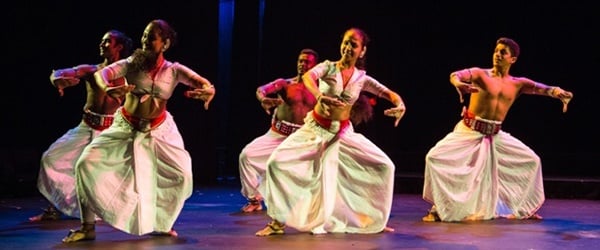Home | Blog | Sydney Festival
Sydney Festival
Image: Jamie Williams
Sydney Festival is one of my favourite times in the yearly calendar. So far it has not disappointed.
I am in the middle of a period that is both joyful and a misery, filled with anxiety and very little sleep; the lead up to production week into performance of my own (first) contribution. (More about that later.) With too much to do I went AWOL and seized the moment to squeeze in a few guilty pleasures, namely a ballet class and two shows, one opening and one closing, as part of the Sydney Festival line-up.
As a contemporary indigenous dance maker myself, it was fortuitous that both works focused on ritual and ceremony in life as contemporary performance.
Sri Lankan company Chitrasena presented Dancing For The Gods. This company was founded in 1943, and is credited for influencing the likes of Martha Graham and Paul Taylor. This is the third time they have toured Australia, first in 1963, then 1972. Dancing For The Gods consisted of several shorter dances honouring the deities and replicating rituals and acts of heroism. A spectacular mix of dancing and live drumming on a very spare stage.
Although first staged in the 20th century, this was a celebration of form born from an ancient legacy, with a history dating back to the time of Buddha. Legs bent, grounded hips positioned low in full squats and deep seconds, intricate formation changes and delicate gestures, with feet adorned in metal, beating a tattoo in concert with the drummers.
The drummers were captivating, almost upstaging the dancers, with their nuanced head flicks, organically coordinated with specific accents within the rhythms; a mixture of choreographed and ongoing improvised body responses to the shift in speed and accent.
I am always interested in the appropriation of Western movement vocabulary in this context, especially when it is successfully developed and integrated into another genre. I don’t know if this was the case but I witnessed a pirouette and several leg extensions that looked balletic, only they weren’t. The feet were flexed, finished in a deliberate sickled ankle, the accompanying postures still maintaining the overall cultural aesthetic.
It was then that I noticed that this company is very contemporary, reproducing what may have previously been part of a much larger spectacle in this smaller, pared-back scale. It was the kindred spirit that recognises and appreciates the enormous effort it takes to recontextualise a movement that belongs to a people rather than a singular author.
So grateful for the rare opportunity to witness a living conduit between ancient and modern dance traditions.
Sunday night I saw the final performance of Tamara Saulwick’s Endings, not billed as a dance/movement work at all, but a sonic installation consisting of manipulated sound playing from several analogue sources, from turntables to cassette tape players, reel to reels stretched to form the pearly gates, while playing the recorded interviews of brushes with death; other people’s endings.
The set was busy and extremely complicated, although none of that was communicated. Instead it enhanced a clear uncluttered rendering of the effect the end of life has on the remaining living.
So many stand-out moments; Paddy Mann’s soft folk melodies which peppered the fractured stories. The simple use of light designed by Ben Cobham (bluebottle) suspended from several points from the ceiling, manipulated higher or lower by the performers, swung like pendulums and held aloft while walking to form a follow spot of sorts or a halo. The intimate stories simply communicated minus melodrama. The seemless choreographic play between objects and performers rendered this one of the most moving and captivating non-dance dance performances I have attended in a long time.
– by Vicki Van Hout

